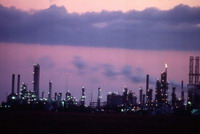Oil prices fall to their lowest level in six weeks
Oil futures reached the lowest level in six weeks after a mixed government inventory report failed to offset a belief that supplies are growing faster than demand.

Investors shrugged off OPEC's decision to keep production levels steady, a possible sign prices have peaked for the year, analysts said.
In its weekly inventory report, the Energy Department's Energy Information Administration said crude supplies plunged by 8 million barrels last week, much more than the expected 700,000 barrel decline.
That caused oil prices to jump briefly above $90 a barrel. But other aspects of the report weighed on prices as the day wore on. Crude supplies grew at the closely-watching Nymex delivery terminal in Cushing, Oklahoma. Inventories of heating oil rose when analysts had expected a decline, and gasoline supplies rose more than expected.
"Overall, this is a mixed report," said Tim Evans, an analyst at Citigroup Inc., in a research note.
Earlier Wednesday, Organization of Petroleum Exporting Countries ministers meeting in Abu Dhabi, United Arab Emirates, said the cartel would leave output unchanged "for the time being," because the world was "well supplied" and crude reserves are at comfortable levels.
That also caused a brief price spike. But there are signs OPEC nations are already producing more than their production quotas, and some analysts expect OPEC output to increase even further in the weeks to come.
Light, sweet crude for January delivery fell 83 cents to settle at $87.49 a barrel on the New York Mercantile Exchange, oil's lowest close since Oct. 24. Prices continued drifting lower in after-hours trading, dipping below $87.
Other energy futures were mixed. January gasoline fell 3.47 cents to settle at $2.217 a gallon on the Nymex, and January heating oil fell 2.25 cents to settle at $2.4893 a gallon. January natural gas rose 3 cents to settle at $7.185 per 1,000 cubic feet on the Nymex.
In its report, the EIA said inventories in Cushing, Oklahoma, rose by 700,000 barrels during the week ended Nov. 30, the third week in a row supplies there have grown. Activity at the Cushing terminal is studied closely by oil traders because it is the physical delivery point for Nymex crude. Falling supplies there are seen as a symptom of a tight market, and those concerns ease when Cushing inventories rise.
Refinery activity was unchanged last week at 89.4 percent of capacity. Analysts surveyed by Dow Jones Newswires, on average, had expected refinery utilization to rise by 0.1 percentage point to 89.5 percent of capacity.
Supplies of gasoline rose by 4 million barrels, much more than the 700,000-barrel increase analysts had expected. And inventories of distillates, which include heating oil and diesel fuel, rose by 1.4 million barrels, countering analyst expectations for a 400,000-barrel decline.
Some of the decline in crude supplies can be explained by oil imports, which fell last week by an average of 980,000 barrels a day to 9.4 million barrels a day. Gasoline imports rose last week by 334,000 barrels a day to an average of 1.2 million barrels a day.
Gasoline demand slid last week by about 90,000 barrels, and is up by 0.2 percent over the last four weeks compared to the same period last year, the EIA said. Analysts consider year-over-year demand growth of less than 1.5 percent to be low.
Oil prices have dropped about $10 from all time-highs near $100 in a little over a week on evidence of rising inventories at Cushing, on speculation that OPEC would boost supplies and on evidence that some OPEC countries are already producing more oil than their quotas call for.
OPEC output could jump by another 300,000 to 400,000 barrels a day once oil fields in the United Arab Emirates return to service from seasonal maintenance, wrote Costanza Jacazio, an analyst with Barclay's Capital, in a research note. Last month, Saudi Arabia's oil minister said the kingdom is producing 9 million barrels a day, more than its quota.
Despite holding output steady, OPEC ministers plan to meet again Feb. 1 to review their decision.
Analysts say a price decline on a day with bullish oil headlines could indicate that the market has peaked for the year and begun a seasonal decline.
"How the market finishes today could tell us what prices really want to do," said Peter Beutel, president of the energy risk management firm Cameron Hanover, in a research not
Subscribe to Pravda.Ru Telegram channel, Facebook, RSS!

